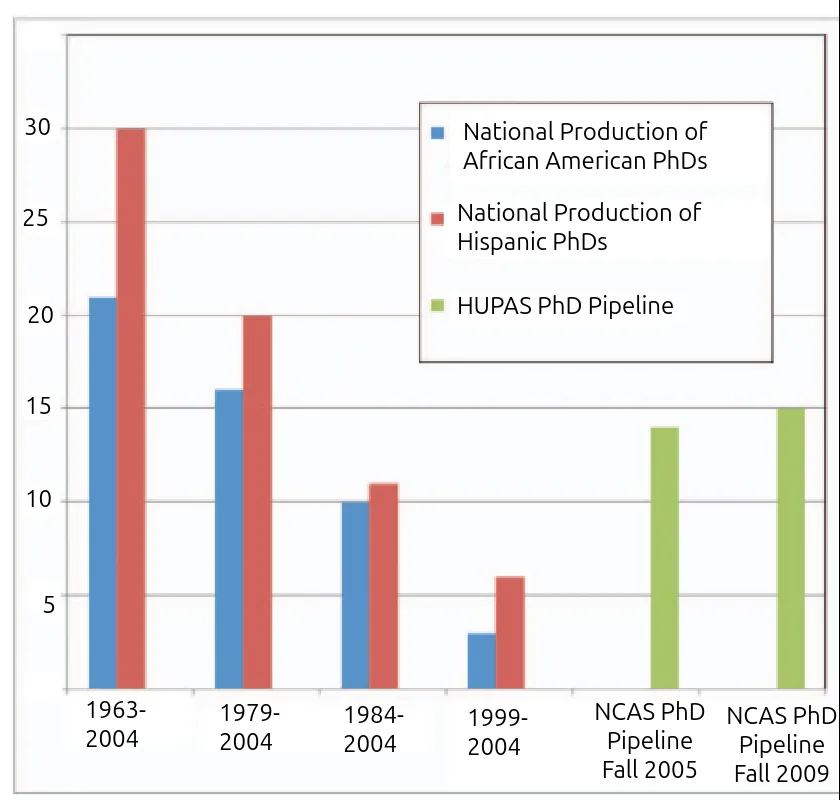Quick 8-minute read summarizing The Howard University Program in Atmospheric Sciences (HUPAS): A Program Exemplifying Diversity and Opportunity. Source cited at the end.
Picture this: It’s 1996, and in the entire United States, you can count the number of Black female PhDs in atmospheric sciences on one hand. Five women, in thirty years. That’s not just a gap - it’s a canyon.
But at Howard University, a group of visionaries saw something different. They saw an opportunity to transform not just their institution, but an entire field of science. In 1996, Howard University made history by launching the Howard University Program in Atmospheric Sciences (HUPAS) - the first advanced degree program in atmospheric sciences at any Historically Black college or University (HBCU).
The Birth of Something Special
The story of HUPAS actually begins a few years earlier. In October 1991, Dr. William Gates, then Chairman of Howard University’s Department of Physics, proposed creating a comprehensive atmospheric sciences research center. This vision materialized in 1992 when NASA’s Minority University Research and Education Division (MURED) awarded Howard University a grant to establish the Center for the Study of Terrestrial and Extraterrestrial Atmospheres (CSTEA).
Under the leadership of Dr. Arthur N. Thorpe, who became director in 1993, the center focused on training underrepresented minority American students in atmospheric sciences. Dr. Thorpe implemented policies that laid the groundwork for HUPAS, including aggressive recruitment at HBCUs, a mandatory seminar series, and a commitment to supporting American minority students.
But perhaps the most significant development came in 1994 when CSTEA, with NASA’s support, began strategically building its atmospheric sciences expertise. The center hired Dr. Vernon R. Morris, an atmospheric chemist, in the Department of Chemistry. This was followed by the recruitment of Dr. Gregory Jenkins, an atmospheric scientist, in Physics, and Dr. Sonya Smith, who brought expertise in turbulence and wake vortex dynamics to the Mechanical Engineering department. These strategic hires would form the cornerstone of what would become HUPAS.


When CSTEA began its student training activities in 1992, the Center started from an initial cohort of three undergraduate and sixteen graduate students. By Fall 1996, CSTEA was supporting seventeen undergraduates and eighteen graduate students. In its first five years, CSTEA celebrated eleven PhD graduates, ten Master’s degrees, and twelve Bachelor of Science degrees.
The mid-1990s stats were stark: African Americans and Native Americans trailed all other racial groups enrolled in atmospheric sciences. In fact, between 1973 and 2003, only five African American women earned PhDs in the field nationwide. A logical extension to the CSTEA training programs was needed to address this disparity.
The full proposal for HUPAS was developed over a 2 year period (1996-1997), with a single atmospheric chemistry course in 1996. The final version was presented to the Howard University Board of Trustees in 1997, and it was officially approved for implementation as a degree-granting program in 1998. The program remains a graduate school program with three “parent” departments: Chemistry, Physics and Astronomy, and Mechanical Engineering. A program director served as the administrative focal point for the program and was usually a tenure-track faculty member teaching HUPAS courses from one of the three parent departments. The position rotates among the active faculty teaching in the program about every 2 years. Like a snowball rolling downhill, the program quickly gathered momentum. By 1998, five tenure-track faculty members were hired across the parent departments that could teach HUPAS courses.
HUPAS didn’t grow in isolation. NASA provided the initial funding through CSTEA, but the program really took flight when it received funding from NOAA’s Educational Partnership Program in 2001. This led to the creation of the NOAA Center for Atmospheric Sciences (NCAS), a consortium led by Howard University that included other minority-serving institutions and major research universities. Students weren’t just learning in classrooms - they were chasing storms (African Easterly Waves; NAMMA experiments) in West Africa, measuring air quality (Beltsville), and sailing across oceans to study African dust plumes (AEROSE experiments).
One of the program’s crown jewels emerged in Beltsville, Maryland. What was once an underutilized plot of land transformed into a world-class research facility. Students who might never have considered atmospheric sciences were suddenly operating advanced radar systems and analyzing climate data.
The numbers tell a remarkable story. In its first decade, HUPAS produced more African American PhDs in atmospheric sciences than the total number reported by the National Science Foundation over the same period. Between 2006 and 2009, HUPAS produced 4 African American female PhDs - nearly matching the national total from the previous 30 years. By 2009, the program had grown from 5 to 19 students (a 400% increase). By 2012, the program had awarded 34 PhDs and 37 MS degrees, with many graduates going on to work at NASA, NOAA, and other prestigious institutions.
Facing the Headwinds
But success didn’t come without challenges. One of the biggest hurdles has been managing faculty workload. HUPAS professors often juggle their regular departmental duties with program responsibilities, without additional compensation or recognition. For untenured faculty, this can be particularly challenging as they try to balance teaching large introductory courses with their HUPAS commitments.
The program has also grappled with administrative challenges. Faculty members often handle administrative tasks themselves, taking time away from teaching and research. And like many interdisciplinary programs, HUPAS has faced challenges in how tenure evaluation processes recognize their unique work. Traditional academic departments sometimes viewed interdisciplinary programs with uncertainty, and resources were stretched thin.
Looking to the Future
Despite these challenges, the future of HUPAS looked bright, with several key recommendations from the cited work below for continued growth:
First, there’s a push for better recognition of faculty contributions, including the development of workload policies that support interdisciplinary work. The program could benefit from dedicated faculty positions and increased administrative support, including a designated common space for the HUPAS community.
There’s also an emphasis on strengthening research infrastructure and expanding partnerships. The program’s three-tiered recruitment strategy - involving partnerships with minority-serving institutions, summer internships, and field research experiences - had proven effective and could be expanded.
Perhaps most importantly, HUPAS continues to embrace its interdisciplinary nature as a strength. By bringing together expertise from multiple fields, the program prepares students to tackle complex climate challenges that require diverse perspectives and skills.
The story of HUPAS is more than just an institutional success - it’s a blueprint for increasing diversity in STEM fields. The program had grown from 5 to nearly 20 active students from 1996 to 2012, and it is bigger than ever now, representing a spectrum of backgrounds: African American, Hispanic, Caribbean, African, and more. Through careful planning, strong partnerships, and dedicated faculty, HUPAS has shown how targeted programs can create pathways for underrepresented students in scientific fields. As climate change continues to present new challenges, the diverse perspectives and expertise fostered by programs like HUPAS will be more crucial than ever.
Want to learn more about atmospheric sciences or HUPAS? Check out Howard University’s atmospheric sciences department website for more information.
Paper Title: The Howard University Program in Atmospheric Sciences (HUPAS): A Program Exemplifying Diversity and Opportunity
Authors: Vernon R. Morris, Everette Joseph, Sonya Smith, and Tsann-wang Yu
Submitted to Journal of Geoscience Education. DOI: 10.5408/10-180.1
Additional historical background was acquired from the Five-Year Report: April 1992-December 1996 on the CSTEA by Dr. Arthur N. Thorpe, and Dr. Vernon R. Morris.